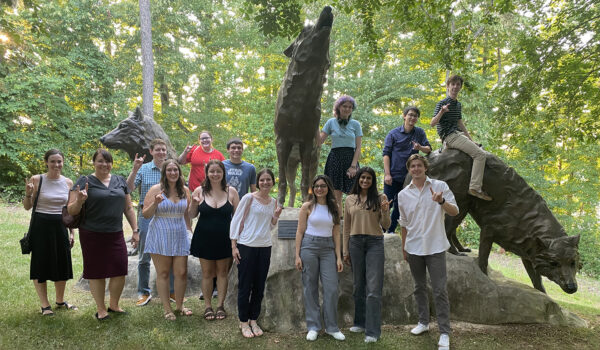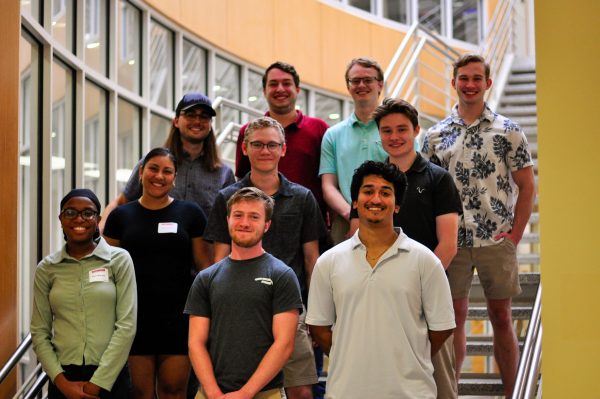Past Projects
2023

Self-Driving Robo-Fluidic Lab for Accelerated Discovery of Clean Energy Materials
Faculty: Milad Abolhasani, Chemical & Biomolecular Engineering Associate Professor
Research Group Website: abolhasanilab.com/
REU Participant: Teagan Della Cerra
Robot-in-the-loop, data-driven experimental research in thin film photovoltaics to pinpoint the origins of degradation
Faculty: Aram Amassian; MSE Professor
Research Group Website: mse.ncsu.edu/amassian/
REU Participant: Hiba Laghzizal
Data-Driven Characterization of Energy Material Deformation During Ion Insertion
Faculty: Veronica Augustyn; MSE Associate Professor
Research Group Website: mse.ncsu.edu/augustyn/
REU Participant: Emma Schatz
Machine Learning Methods for Calculating Vacancy Formation Energies in High Entropy Ceramics
Faculty: Don Brenner, MSE Professor and Department Head
Research Group Website: mse.ncsu.edu/brenner/
REU Participant: Jalen Pryor
Using data to design LEDs emitting in the ultraviolet for disinfection applications
Faculty: Ramon Collazo, MSE Associate Professor
REU Participant: Jakob Fick
Lightweight, high strength, and corrosion-resistant alloys at the low material cost
Faculty: Rajeev Gupta, MSE Associate Professor
Research Group Website: mse.ncsu.edu/rkgupta2/
REU Participants: Adam Logan and Kevin Huang
Dynamic Interplay between Phase transformation and Material Degradation in Extreme Environments
Faculty: Bharat Gwalani, MSE Assistant Professor
Research Group Website: mse.ncsu.edu/gwalani/
REU Participant: Alice Pandaleon
AI-Driven Control of Printed Organohydrogels through Ultrafast Imaging
Faculty: Lilian Hsiao, CBE Assistant Professor
Research Group Website: http://www.hsiaolab.com
REU Participant: Amory Gaylord
Data Driven Quantum Tunneling Molecular Devices
Faculty: Martin Thuo, MSE Professor
Research Group Website: mse.ncsu.edu/thuo/
REU Participant: Jack Austin
Data Driven Design of NP-based Materials
Faculty: Yara Yingling, MSE, Biomedical Engineering & Physics Professor
Research Group Website: mse.ncsu.edu/yingling/
REU Participants: Caroline Cunningham and Siri Mudunuri
2022

Robot-in-the-loop, data-driven experimental research in thin film photovoltaics to pinpoint the origins of degradation
Faculty: Aram Amassian; MSE Professor
Research Group Website: mse.ncsu.edu/amassian/
REU Participant: Gabe Graves
Data-Driven Synthesis of Metastable Hydrated Transition Metal Oxides
Faculty: Veronica Augustyn; MSE Associate Professor
Research Group Website: mse.ncsu.edu/augustyn/
REU Participant: Carter Wunch
Machine learning optimization of strain sensors based on piezoelectric properties of 2D layered materials
Faculty: Nina Balke, MSE Associate Professor
Research Group Website: mse.ncsu.edu/balke/
REU Participant: Ian Lyons
Machine Learning Methods for Calculating Vacancy Formation Energies in High Entropy Ceramics
Faculty: Don Brenner, MSE Professor and Department Head
Research Group Website: mse.ncsu.edu/brenner/
REU Participant:Skyler Kauffman
Using data to design LEDs emitting in the ultraviolet for disinfection applications
Faculty: Ramon Collazo, MSE Associate Professor
REU Participant: Bryan Wright
Materials Research Data Analysis for Coastal Science
Faculty: Wenpei Gao
Research Group Website: mse.ncsu.edu/gao/
REU Participant:Ishan Ghosh
Improving properties of lightweight, high strength, and corrosion resistant alloys with data science
Faculty: Rajeev Gupta, MSE Associate Professor
Research Group Website: mse.ncsu.edu/rkgupta2/
REU Participants:Andrew Hollett
Design of energy sustainable materials through point defect informatics
Faculty: Doug Irving, MSE Professor
Research Group Website: mse.ncsu.edu/irving/
REU Participant: Jonathan Paul
Machine Learning for Discovery of P-recovery Materials
Faculty: Jacob Jones, MSE Professor
Research Group Website: mse.ncsu.edu/jones/
REU Participant: Zhane McCleod
Accelerated Design of Green Cellulose Membranes for CO2 Capture
Faculty: Melissa Pasquinelli
Research Group Website: faculty.cnr.ncsu.edu/melissapasquinelli/
REU Participants: Mariel Gomez
What Participants Are Saying…
Ishan Ghosh majors in Materials Science and Engineering at Clemson University. Learning about the MAT-DAT REU through a friend also looking at REU programs, Ishan calls the experience “enlightening.” The program expanded his horizons, giving him an overall unique experience. Ishan’s “aha moment” was getting his Python code to compile without any errors. Sharing kudos to MSE student coordinator Hillary Stone, his favorite part of the program was making connections with others from different backgrounds who share similar interests. To break up his time researching, Ishan recommends a visit to the State Farmer’s Market near NC State’s campus. His parting quote: “Go in with an open mind ready for whatever may come your way.”
Drew Hollett majors in Civil Engineering at Tufts University. Drew was recommended to the MAT-DAT REU by a professor at school. He says the experience was very rewarding and gave him the opportunity to do theoretical and experimental work. He picked up skills applicable to other fields and got to picture life as a graduate student. Giving praise to MSE Professor Yingling, student coordinator Hillary Stone, and Professor Gupta’s research group, his favorite part of the program was choosing how to solve a research problem due to the open-ended curriculum. Drew loved the openness of the NC State campus and surrounding areas like Lake Raleigh. Drew strongly recommends the REU. His parting quote: “Sometimes you just need to take a break to get the answer to a hard question.”
“It’s a great program for students interested in learning about how computer science and machine learning can be applied to engineering.”
– Drew Hollett
Ian Lyons majors in Chemistry at the University of Washington. Ian learned about the MAT-DAT REU through the NSF website. He was excited to work directly with his PI, Professor Balke, and he enjoyed learning how to code and apply machine learning to real-world problems. His favorite part of the program was working with actual real-world data. “The satisfaction of seeing your hard work pay off felt very nice,” says Ian. He recommends the REU to anyone interested in doing research in the future. He thinks it is a good way to quickly find out if research is for you and what your strengths and weakness are. It also helps to build many skills that are necessary to succeed in the academic world with much less pressure. For recreation, Ian was drawn to the NC State rock climbing wall in the Carmichael Gym, as well as the rock climbing community. His parting thoughts: “Take this opportunity to try new things and spend time with your roommates! We went skydiving and I am glad to have had the group experiences we had. There are not a lot of people on Centennial Campus during the summer, so get to know the people that are here. Introduce yourself and exchange socials at all of the welcome REU events because there are not many chances afterward to do so because people are most open to making friends when they first arrive somewhere new.”
Zhane McCleod majors in Aerospace Engineering at the University of Florida. Zhane learned about the MAT-DAT REU through her job. She feels grateful for the exposure to Python, machine learning, as well as graduate school. Zhane loved how free this program was: “Housing and travel are paid for. You are paid generously, even if you don’t have a summer internship or summer classes, an experience like this allows one to travel. I was able to work on my project in my own space and on my own time.” Zhane’s “aha” moment was discovering the machine learning methods linear regression, decision trees, and random forests will not train datasets with missing values unless rows with missing values are deleted. She had nothing but amazing notes for her mentor, Josh Harris, and her PI, Jacob Jones, and his research group. “I’ve grown more as a bold and confident woman with the help of our regular group meetings,” says Zhane. “I was surprised to learn that NC State has three campuses and that Centennial Campus is as big as it is. I was also surprised how NC State has a campus devoted to engineering and textiles.” Zhane shares her parting thought “The REU program is a mixture of fun, learning, and summer.”
Questions about the MAT-DAT REU? Email mse-reu-matdat@ncsu.edu
Program Details Application Requirements Current Projects